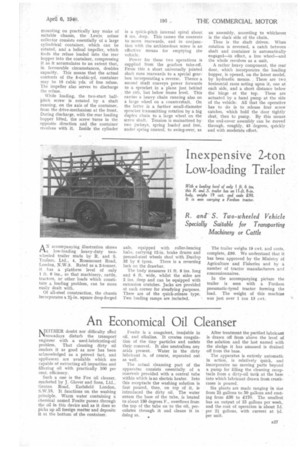An Economical Oil Cleanser
Page 37

If you've noticed an error in this article please click here to report it so we can fix it.
NEITHER doubt nor difficulty nted nowadays disturb the transport engineer with a used-lubricating-oil problem. That cleaning dirty oil renders it as good as new has been acknowledged as a proved fact, and appliances are available which are capable of extracting all impurities and filtering oil with practically 100 per cent. efficiency.
Such a one is the Fox oil cleaner, marketed by J. Glover and Sons, Ltd., Groton Road, Earlsfield London, SAVA& It functions on the washing principle. Warm water containing a chemical named Foxite passes 'through the oil in this device and as it does so picks up all foreign matter and deposits it at the bottom of the container.
Foxite is a coagulent, insojuble in oil, and alkaline. It creates coagulation of the tiny particles and assists their removal. It also neutralizes any acids present. Water in the dirty lubricant is, of course, separated out as well.
The actual cleansing part of the apparatus consists essentially of a reservoir provided with a central tube within which is an electric heater. Into this receptacle the washing solution is first poured, then, on top of it, is introduced the dirty oil. The water enters the base of the tube, is heated to about 180 degrees F., overflows from the top of the tube on to the oil, percolates through it and deans it in doing so.
After treatment the purified lubricant is drawn off from above the level of the solution and the last named with the sludge it has amassed is drained off from the base.
The apparatus is entirely automatic in action, is relatively quick, and incorporates no moving parts beyond a pump for filling the cleaning receptacle from a dirty-oil tank at the base into which lubricant drawn from crankcases is poured.
Six plants are made ranging in size from 2 gallons to. 50 gallons and costing from 130 to 2170. The smallest has an output of 15 gallons per week, and the cost of operation is about 1d. per 21 gallons, with current at id. per unit.




























































